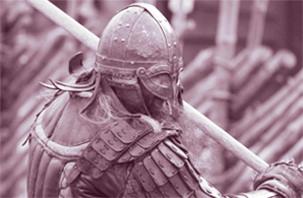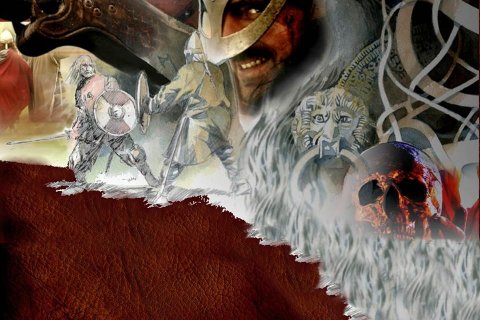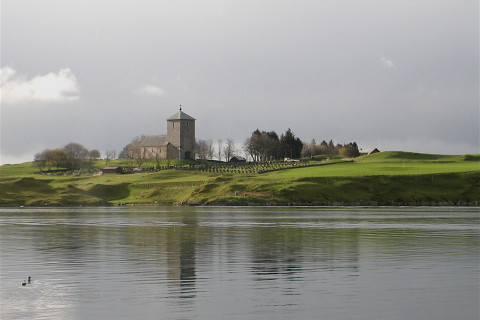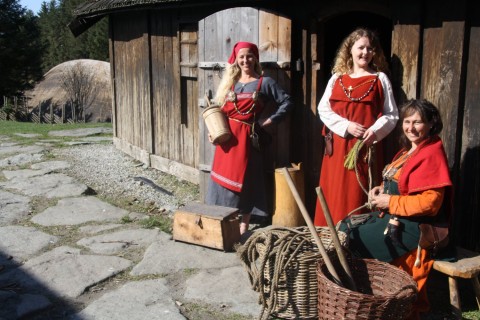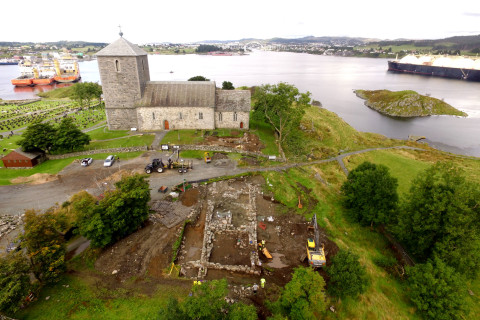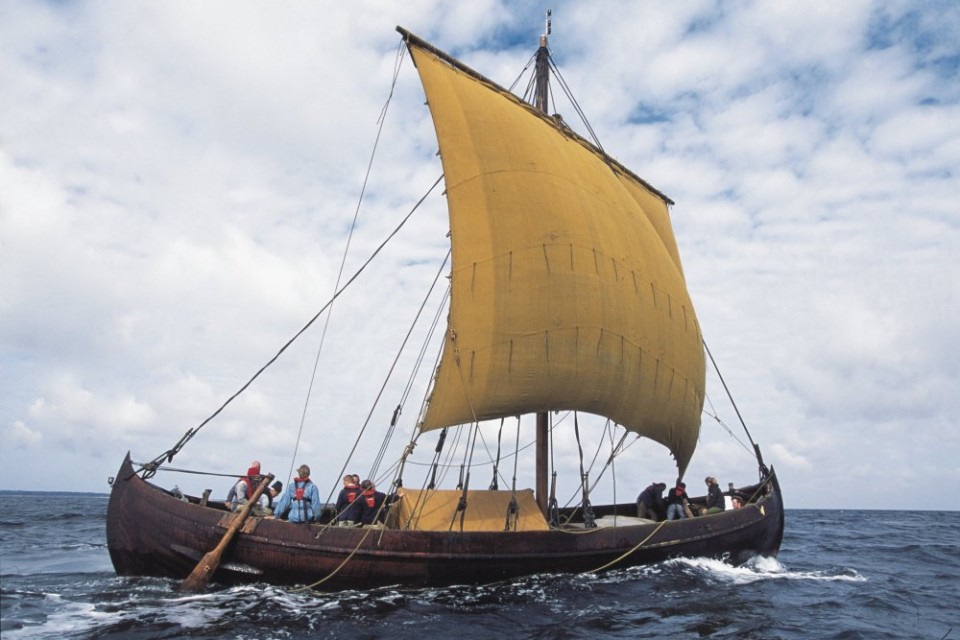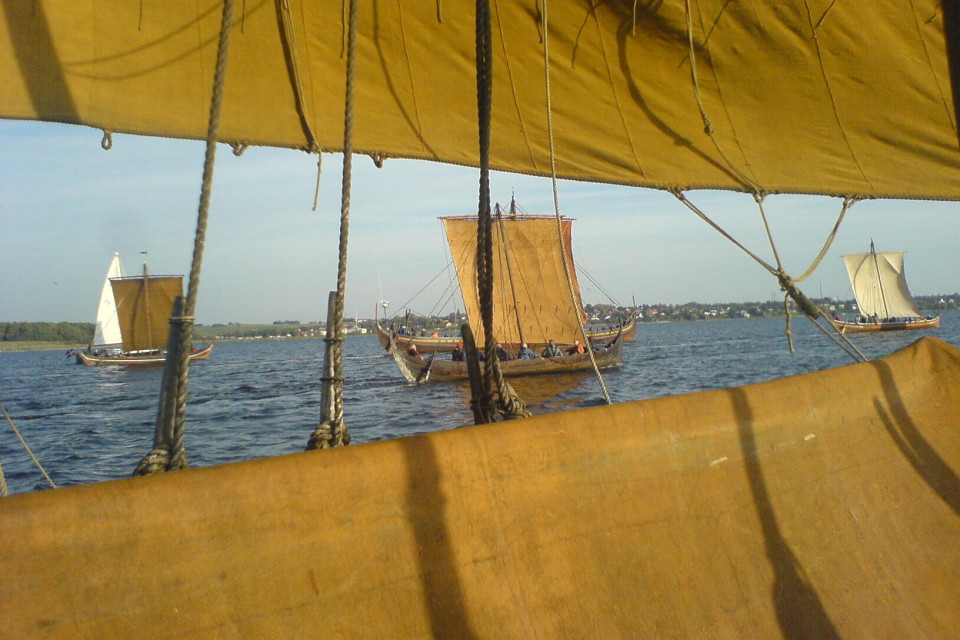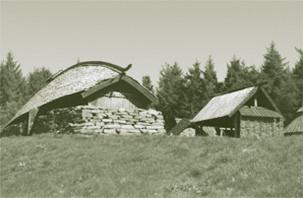Viking ships
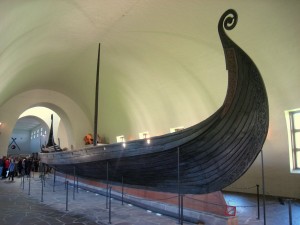
The Oseberg ship in the Viking Ship Museum in Oslo. The ship was built around 820. The burial took place in 834. Dendrochronological studies carried out in 2009 tell that the Oseberg ship was built of oak from the area around the Avaldsnes. See: Arkeologi i nord: Osebergskipet fra Søvestlandet. (Foto Wikimedia commons)
Text: Marit Synnøve Vea
THE LEGENDARY VIKING SHIPS
Without the Viking ships, there would be no Viking Age. Norse sagas, skaldic poems and contemporary foreign sources describe the Viking ships as marvelous at sea:
– The Viking ships had flexible, clinker-built hulls that followed the waves as living beings.
– The best ships are compared with dragons, birds and sea serpents.
– The Viking ships could easily be drawn up on a beach.
When Magnus the Good (1047) put his ships to sea, it was as if a swarm of angels from the King of heaven – soared over the waves. (The skald Arnorr)
The Vikings sailed over vast distances with these ships, from America in the west to Asia Minor in the east, and perhaps even farther. This suggests that the written sources are right: Viking ships were unique for their time.
It was the seaworthiness of the Viking ships, together with the Norsemen’s knowledge of navigation and seamanship, which made it possible for them to conquer the ocean. The Vikings’ understanding of the sea is also reflected in the Old Norse language that has about 150 words for waves.
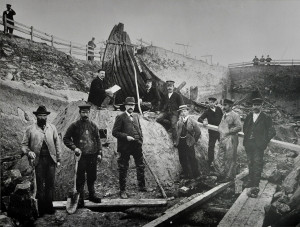
Excavations of the Oseberg ship, 1904. Photo Oldsaksamlingen
VERY FEW VIKING SHIPS HAVE BEEN FOUND
According to the Old Norse laws, the Norwegian leiðdang (defence fleet) could mobilize at least 310 ships when danger threatened. In addition to these came all of the “private” Viking ships. Based on this, there must have been built several thousand Viking ships during the Viking Age. However; very few burial ships and ship wrecks have been found.
The ships that have been found are in many pieces. Often large parts are missing. We have to rely on different interpretations when the ships are put together, and when reconstructions are made.
Therefore we must admit that we still don’t know much about how the Viking ships were built, how they were sailed, how they were rowed or how they were navigated. Nor do we know a lot about the different ship types that the Norse literature describes.
What we write here can change subject to new findings and new research methods.
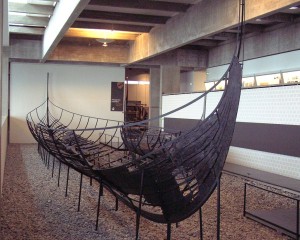
Skuldelev II. Ship wreck excavated in Roskilde fiord in 1962. Was built in the Dublin area ca. 1042. . (Foto Wikimedia Commons)
THE DIFFERENT SECTIONS (N ROM) OF THE SHIPS
- The ships were divided into sections, i.e. the space between two ribs. (N. band/spant)
- Each section (N rom) had two half-sections (N halv-rom)
- One section is the same as one seat (N sesse) and one pair of oars. That is: A ship of 20 sections will be called a 20-sesse and it has 40 oars.
- According to the sagas, between one and four men were sitting at each oar of the ship.
- If four men rowed at the same time, it was as if the ship flew over the sea.
DIFFERENT TYPES OF VIKING SHIPS
The Norse sagas have a variety of names for different vessels, like bátr, skip, feræringr, fley, byrðingr, skúta, stórskip, dreki, karfi, knórr, snekkja, langskip,landvarnarskip, herskip, bússa, hafskip, súð. These various designations must describe differences in appearance, size, construction techniques, use etc.
Some ships were pure cargo vessels designed for sailing over large ocean areas. These were sturdy and broad and had only a few oars that were used during maneuvering in harbor. The typical warship was long and narrow, designed both for rowing and sailing, but there were also sturdy warships called “great ships” or “busser”, like Olav Tryggvason’s fabled Long Serpent and Harald Harraade’s Serpent.
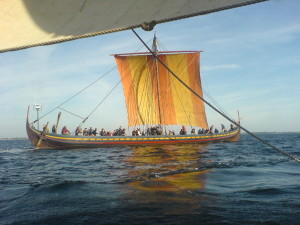
Sea Stallion. Replica of Skuldelev II. 30 m long og 3.8 m wide. Is probably what the sagas call a skeið. (Photo Terje Andreassen)
It looks like the Danish longships in general were narrower than the more sturdy Norwegian longships that were designed for rougher seas. This also applies to the warships as they are described in the sagas.
Generally, we can say that a vessel under 15 meters is called a boat; a vessel of 15 meters and more is a ship.
1. LONGSHIPS – WARSHIPS:
Ships with many oars that could be both rowed and sailed. Some warships were long, narrow and flat-bottomed, first and foremost meant to be good rowing ships. We believe that the typical Danish “skeids” were such ships. Others were large and sturdy, first and foremost meant to be sailed, but they could also be rowed. These ships had high freeboard and were easier to defend. They also managed better than the “skeids” in heavy seas.
From the 1100’s large and sturdy ships were used both as war vessels and merchant vessels.
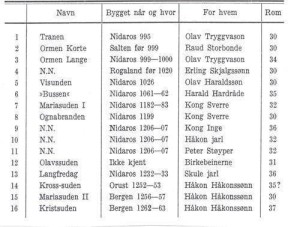
Longships over 30 meters that is known from the sagas. (After Brøgger and Shetelig: “Vikingeskipene”, Dreyer 1950)
- Ordinary longship: From 20 – 25 sections (ie 40 – 50 oars).
Probably the ships with 25 sections were best suited as warships. Shetelig and Brøgger writes in their book: “Vikingeskipene”: “It seems that the ship of 25 sections (halft þritugt skip) has been the most suitable and most effective “.
- Great ship: (stórskip) Large longship that may have had from 30-37 rooms (ie 60 to 74 oars). The term “great ships” may also have something to do with how sturdy the ships were.
- Skeid (Skeið): Long, narrow warships of between 20 to 35 sections. Lower freeboard, and not as sturdy as the “busses”. Were better as rowing ships than sailing ships. The Danish warships are often referred to as “skeids”. Note that skaldic poems use the word skeid for both large and small warships. In Olav Tryggvason’s saga we can read that Erling Skjalgsson had a ‘skeid” of 30 sections and a crew of 200 men. ”..and all the crew memers were very skilled men”.
- Busse (Bússa): Large, sturdy, sea-going longships which were first developed as warships. The Long Serpent was probably a “busse”. The saga describes it thus; the bulwarks were as high as in sea-going ships. Still, a skaldic poem also calls the Long Serpent a “skeid”. A busse could have up to 35 sections. The busses were better sailors and could take rougher seas than the skeids. Later, the busses were used for overseas trade, one example being Avaldsnesbussen that sank outside Iceland in 1343.
- Barde (Barði): A sturdy warship with a special, ironstudded prow construction which may have been a kind of battering ram to strike enemy ships. The word comes from barð, meaning beard/brim which denoted this particular prow. In the saga of Olav Tryggvason we can read:”Earl Eirik had a very large barde which he used on his Viking voyages; a beard was there on the higher part of both prow and stern, and thick plates of iron going from thence all the breadth of the beard right down to the water-line”.
- Sud (Súð): Large longships from 20 sections and upwards. Were developed in the Medieval times and may have been an evolution of the” busse-ships”. Some of the greatest of Haakon Haakonsson ships in the 1200s was the “suds”. The largest was Kristsuden who had 37 sections.
- Snekke (Snekkja): Normally a ship of 20 sections, but it could be as large as 30 sections. At war it was perhaps mainly used as a crew carrier .
- Drake/dragon (dreki): Large warships with dragon heads. Ships for chieftains and kings. Meant to show the owner’s status, and could be used both for “skeids” and “busses”. From 25-sections and upwards. The dragon ships were generally the largest ships in the fleet.

Draken Harald Hårfagre(Dragon Harald Fairhair). About 35 m long and 7.5 m wide. A recreation of the ship types the sagas call “great ships”. King Harald Fairhair is said to have had several such “great ships”. These ships were more sturdy than the “regular” leidang ship. Ships like Dragon Harald Fairhair can also have been called busser. (Photo Dag Sjøvold)
2. MERCHANT SHIPS:
Wide vessels designed for sailing, a few oars for maneuvering in port, stuck deep in the sea. An exception was the karves which were flat-bottomed and could have from 13 to 16 pairs of oars.
- Knarr (Knarr/knórr): Sea-going trading ship (in which the Vikings also sailed to Vinland and Greenland). Mark, however, the skaldic poem Haraldskvadet by the skald Thorbjørn Hornklove (around 900 AD), refers to the knarr as a warship.
- Karve (karfi ): A karve was smaller than an ordinary long ship, from 13 to 16 sections. The karves could also be used for bringing supplies and equipment to the war fleet and for transporting passenger along the coast. The Gokstad ship and the Oseberg ship are normally classified as belonging to the karve class.
- Byrding (Byrðing): Vessel for carrying goods along the coast (could also sail to the Faeroes and Iceland). The Saga of King Sverre tells that byrdings sailed through the strait Karmsund every day in the summer season.
Knarrs as warships in the battle of Hafrsfjord
Heard hast how the high-born one
in the Hafrsfjord fought,
the keen-eyed king’s son,
‘gainst Kjotvi the Wealthy.
Came their knarrs from the east,
eager for combat,
with gaping figureheads
and graven ship-prows.
(Skaldic poem about Harald Fairhair. By Thorbjørn Hornklove)
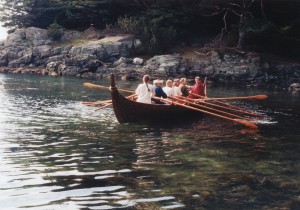
Holmrygr, reconstruction of the largest of the three boats found in the Gokstad ship burial. (Photo. Marit Synnøve Vea)
3. BOATS (vessels less than 15m)
Ships were vessels for the few, while boats seem to have been common for most people. This is reflected in that only 13 ship burials have been found in Northern Europe, while there are found many boat burials. Three smaller boats were also found together with the Gokstad ship. The largest was about 9.75m long, the smallest about 6.5m.
THE LEVY FLEET (LEIDANG)
The leidang (leiðangr) was a system that organized a coastal fleet with the aim of defense, coerced trade, or aggressive wars. All free men were obliged to take part in or contribute to the leidang. The entire leidang was called to arms when invading forces threatened the land. The leidang could also be called out to participate abroad.
The leidang divided the coastal districts into different regions called skipreiða. In times of strife, those living in these regions had to provide a certain number of ships and also equip themselves with men and weapons.The law required every man to arm himself, at a minimum, with an axe or a sword in addition to spear and shield, and for every rowing bench to have a bow and 24 arrows. Ancient Norse sources reveal that this Norwegian defence fleet could mobilise at least 310 ships when danger threatened. We do not know whether the full quota of ships was ever mobilised.
In addition, a warning system consisting of hilltop cairns was created and when enemies approached, these cairns were lit one after the other to warn the people so that they could prepare themselves. In this way the levy fleet along the Norwegian coast could gather in a few days.
Haakon the Good gets the honor of having formed the leidang system around 950, but similar arrangements may have existed long before this time as a defense of petty kingdoms.
Number and size of ships that the Norwegian counties were obliged to contribute with in the leiðangr:
Vikverjene: 60 ships 20-sesser
Grenene: 1 ship
Egdene: 16 ships 25-sesser
Rygene: 24 ships 25-sesser
Hordene: 24 ships 25-sesser
Sygnene: 16 ships 25-sesser
Firdene: 20 ships 25-sesser
Mørene: 16 ships 25-sesser
Romsdølene: 10 ships 20-sesser
Nordmøringene:20 ships 20-sesser
Trønderne: 80 ships 20-sesser
Namdølene: 9 ships 20-sesser
Håløygene: 13 ships 20-sesser + 1 ships 30-sesse
(After: Brøgger og Shetelig: Vikingeskipene, Dreyer 1950)
As far as we know full mobilization of the leiðangr (= 310 ships) was never implemented.
Read more about the leiðangr in the Law of Gulating” (only in Norwegian): Utgjerdsbolken i Gulatingsloven om leidangen

Battle in Hafrsfjord.( Ill. E. Werenskiold)
GLIMPSES FROM THE SAGAS ABOUT VIKING FLEETS AND THE LEIDANG
Saga of Harald Fairhair: Harald had a large dragon and many large ships in the leidang.
In winter he had caused a great frigate (ON dreka mikinn) (a dragon) to be built, and had it fitted-out in the most splendid way, and brought his house-troops and his berserks on board. The forecastle men were picked men, for they had the king’s banner.
From the stem to the mid-hold was called rausn, or the fore-defence; and there were the berserks. Such men only were received into King Harald’s house-troop as were remarkable for strength, courage, and all kinds of dexterity; and they alone got place in his ship, for he had a good choice of house-troops from the best men of every district. King Harald had a great army, many large ships (ON stórskip), and many men of might followed him. (English translation by Samuel Laing)
Thorbjorn Hornklove speak about Harald Fairhair’s ships:
That king thou knowest,
him who at Kvinnar dwelleth,
the hoard-warder of North men,
who has hollow war-ships
with reddish ribs
and with reddened war-shields,
with tarred oar-blades
and with tents foam-besprinkled ( THE LAY OF HAROLD )

Carving found in Bergen
The carving probably shows Haakon Haakonsson’s fleet in 1233. Here you see ships with dragon heads and other large leidang ships. In the middle you also see ships with gilted banners, a kind of wind vanes, that adorn the prow.
Saga of Haakon Haakonssons. Haakon prepares his fleet
When he (Haakon) came to Bergen, he laid his ship in the royal ground, and the othes placed their longships alongside the bridges in the town.
Later he (Haakon) launched his largest ships: Hugroa, Olavssuden, Fitjabranden, Gullbringa and Rygjabranden. But when Hugroa was launched, the lower part of the ship was destroyed. They then immediately took the ship on land again, and repaired it. But the other ships were launched without any incidents. The King’s ships lay along the docks all the way inwards towards the town. Afterwards the King’s lendermen and sheriffs came with large herds og men.
Saga of Olav Tryggvasons: Olav summons the leidang to seil abroad
Not long after these things summoned King Olaf a Thing in the town, and made known to all the people that in the summer would he send an host out of the country, and that it was his will to levy ships & men from each county, & therewith 106 did he make it known how many ships he should require from the fjord there. ¤ Then sent he messengers inland both northwards and southwards, and along the coast on the outside of the islands and inside them along the land, and called men to arms. Thereafter did King Olaf launch the ‘Long Serpent’ & all his other ships great & small; (….)
Moreover had King Olaf eleven great ships from Throndhjem, ships of twenty benches, two smaller ships and victuallers. (English translation: Ethel Harriet Hearn)
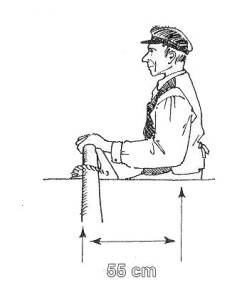
Old NORWEGIAN ALEN = 55 CM
THE LENGTH OF THE NORWEGIAN VIKING SHIP. (AFTER JON BOJER GODAL)
Below is an estimate of how long the various vessels have been in the Viking Age. Keep in mind that length alone is not a complete indicator of how large a ship may be. The beam, draft, freeboard, and hull form are all critical factors in the ship’s actual size and displacement.
We use the following criteria to estimate the length:
– The old Norwegian cubit (alen) was 55 cm
– Keel and lots are always two cubit (alen) per section (N rom).
The length of the longships measured from stem to stern:
Mark; ships with stem and stern that turns out more than average, can be slightly larger
25-sesse (25 sections): ca 35m
Keel and lots are 50 alen = 27.5 m.
In addition: Stem, stern, bulkhead, decorative elements; ca 7.5m
30-sesse (30 sections): ca 42m
Keel and lots are 60 alen = 33.0 m.
In addition: Stem, stern, bulkhead, decorative elements; ca 9m)
34-sesse (34 sections): ca 47m – 48 m
Keel and lots are 68 alen = 37.4 m.
In addition: Stem, stern, bulkhead, decorative elements; ca 10m
35-sesse (35 sections): ca 49m
Keel and lots are 70 alen = 38.5m
In addition: Stem, stern, bulkhead, decorative elements; ca 10.5m
37-sesse (37 sections): ca 52m
Keel and lots are 74 = 40.7m.
In addition: Stem, stern, bulkhead, decorative elements; ca 11.3
40-sesse (40 sections): ca 57m
Keel and lots are 80 alen = 44.0 m.
In addition: Stem, stern, bulkhead, decorative elements; ca 13m
The measurements are based on calculations made by Jon Bojer Godal
Read more about the basis for calculating the size. Only in Norwegian Storleiken på eit drakeskip
Back

